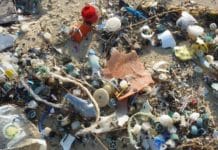
DENVER, Aug. 27 (UPI) — Scientists are finding tiny microplastics, many invisible to the human eye, in rain, drinking water and oceans worldwide, raising questions about their effects on human and animal health.
Although the presence of plastic particles in the world’s oceans is well-documented, recent research shows that plastic fibers also are being found thousands of miles inland.
Microplastics are everywhere.
Plastic microfibers were inadvertently found by scientists measuring nitrogen levels in acid rain in the mountains of Colorado.
Tiny pieces of plastic showed up in 90 percent of rain samples taken from the foothills outside Denver and Boulder, and from remote sites in Rocky Mountain National Park, a 2019 study by the United States Geological Service said.
The fibers, only visible with a microscope, appeared to have come from plastic fabrics and were blue, red, silver, purple, green and yellow. Small plastic beads and shards also were observed with magnification.
“It is raining plastic,” concluded researcher Greg Wetherbee from the Denver-based USGS Hydrologic Networks Branch. Finding plastic fibers on top of 10,300-foot mountain peaks shows that “plastic is ubiquitous and not just an urban condition,” Wetherbee said.
European researchers this year found microplastics and tiny plastic fibers in pristine regions of remote French Pyrenees mountain regions. Researchers said the microplastics were carried by wind. They estimated that France is “blanketed by 2,000 tons of plastic particles” every year.
“Plastic litter is an increasing global issue and one of the key environmental challenges we face on a global scale,” researcher Steve Allen, from Britain’s University of Strathclyde, said in a press release.
Microplastic fibers were also found in Arctic snowfields, new research from the Alfred Wegener Institute and the Swiss WSL Institute for Snow and Avalanche Research SLF reported this month.
Microplastics, defined as pieces of plastic smaller than 5 millimeters, are created from the disintegration of plastic trash or are fabricated for industries, such as microbeads in cosmetics or plastic beads used in abrasive blast cleaning.
Microfibers are plastic filaments released from acrylics, polyester or nylon fabrics and rinsed out of washing machines by the thousands per article of clothing.
Plastic is useful, cheap and can improve human life by keeping food airtight, keep medical supplies sterile or reduce the costs of objects and textiles. But the inability of plastic to biodegrade has caused a worldwide plastic glut, environmental agencies say.
The smallest microfibers and plastics are tiny enough to slip through most filters and even enter the bloodstreams of organisms that ingest them.
An Australian study showed that people are consuming about 2,000 pieces of microplastic a week, or 21 grams a month — about the weight of a credit card.
“No Plastic in Nature: Assessing Plastic Ingestion from Nature to People,” published in June by the World Wildlife Federation based on research by Thava Palanisami at University of Newcastle, Australia, showed that the most plastic is consumed through water, both bottled and tap.
Twice as much plastic is ingested through water in the United States and India as in Europe or Indonesia. Almost all U.S. tap water contains about 5 plastic microfibers per cup, the Australian study showed.
Other high sources of plastic consumed by humans were found in shellfish, beer and salt.
The majority of the world’s virgin plastic has been created from petrochemicals since 2000, the study said.
It’s unclear how microplastics affect human health, but a study published last year by scientists from Johns Hopkins University and University of Toronto shows ingested tiny plastic particles appear to cause reproductive disruption in shellfish and lead to smaller, less-healthy offspring.
In vitro studies on animals show microplastics are toxic to lung cells, liver and brain cells, and plastic fibers “seem to produce mild inflammation of the respiratory tract,” the Australian study said.
Microplastics washed out in laundry and found in rain runoff make their way to the ocean, where other plastic trash also is ground into particles by wave motion.
Some descends to the ocean floor, but other plastic floats in areas like the so-called Great Pacific Garbage Patch, a 600,000-square-mile island of floating plastic twice the size of Texas. A 2015 study cited by the U.S. National Oceanic and Atmospheric Administration estimates 8 million metric tons of plastic end up in the ocean every year.
Since 2006, the U.S. NOAA has operated a Marine Debris Program to focus efforts on cleaning up plastic and so-called derelict man-made marine garbage like abandoned lobster and clam traps.
But the best strategy for removing microplastics from the ocean is preventing them in the first place by better use and recycling of plastics, the agency said.
Its advice: “Plastic has important uses, so stopping production isn’t realistic, but changing your h



